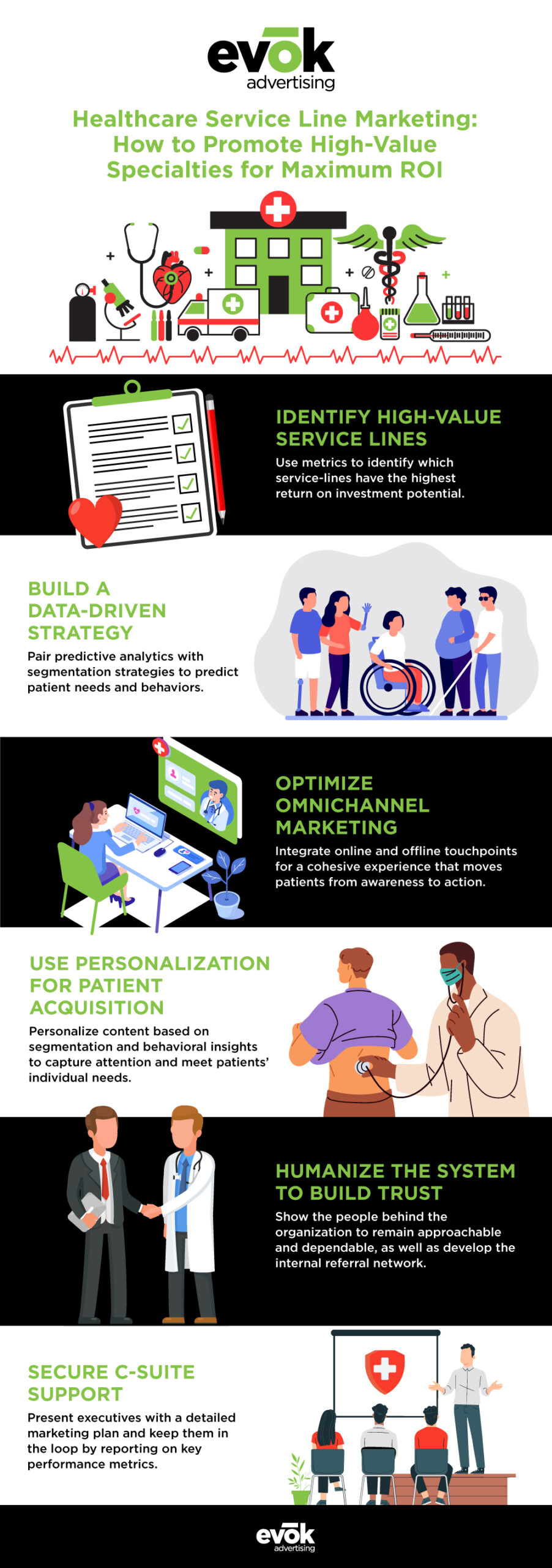
Healthcare Service Line Marketing: How to Promote High-Value Specialties for Maximum ROI
Why Healthcare Service Line Marketing Matters More Than Ever
Today’s patients are empowered consumers with abundant choices. For healthcare organizations, standing out requires more than quality care. It demands strategic, data-driven marketing that highlights high-value service lines, specialties that offer strong clinical outcomes, patient demand, and revenue potential.
Healthcare service line marketing boosts awareness, enhances patient experience, and improves ROI by connecting the right people to the right services. From cardiology to behavioral health, success depends on aligning digital strategy, content, and physician engagement. This blog explores how CMOs can drive service line growth with precision and measurable impact.

Identifying High-Value Healthcare Service Lines for Growth
To maximize the return on investment of healthcare marketing efforts, organizations must focus their resources on the service lines that offer the greatest opportunity for growth, patient impact, and financial sustainability. This begins with identifying what qualifies as a high-value healthcare service line and how to prioritize these specialties within a larger marketing strategy.
What Makes a Service Line High Value in Today’s Market?
A high-value service line delivers strong clinical outcomes, meets patient demand, and generates a significant contribution to an organization’s bottom line. These specialties not only attract a consistent stream of patients but also play a central role in defining an organization’s reputation and competitive edge in the market. A specialty becomes high value when it demonstrates consistent revenue generation, clinical excellence, favorable reimbursement rates, and long-term growth potential. Service lines that meet these criteria often become focal points for hospital service line promotion because they help balance payer mixes, fill capacity, and support broader organizational goals.
Using Financial and Market Data to Prioritize Specialties
To make informed decisions about where to allocate marketing resources, healthcare organizations must take a data-first approach. Financial data, patient volume trends, referral patterns, and payer reimbursement insights can reveal which specialties are already high performers and which have the potential to grow with the right investment. External market conditions, such as population health trends and regional demand for certain services, further shape these decisions.
By analyzing these metrics, healthcare marketers can identify service lines with the highest return on investment potential. Collaboration between marketing, finance, and clinical teams is encouraged to evaluate both performance data and market analytics. When these departments work together, they can build a shared understanding of which services deserve increased visibility and how to align marketing budgets with organizational growth strategies.
Identifying and promoting high-value service lines is one of the most effective strategies for healthcare service line revenue growth. With the right foundation, healthcare organizations can build targeted campaigns that deliver measurable results, improve patient outcomes, and drive long-term success in a rapidly evolving marketplace.
Building a Data-Driven Strategy for Service Line Promotion

To effectively promote high-value service lines, healthcare organizations must build their strategies on a foundation of data. In a market where patients have more options and access to information than ever before, relying on intuition or outdated marketing models is not enough. Data allows CMOs to understand patient needs, anticipate behaviors, and deliver the right message to the right person at the right time. This approach drives stronger engagement, reduces waste, and produces measurable healthcare marketing ROI.
How Predictive Analytics Drive Service Line Decisions
Predictive analytics has transformed how healthcare marketers plan and execute campaigns. By tapping into sources such as electronic health records, billing systems, CRM platforms, and third-party consumer data, organizations can forecast demand for specific service lines and tailor marketing strategies accordingly.
This level of insight supports smarter decision-making across the board. Marketers can analyze which services are most often searched online, which patient demographics are likely to need specific treatments, and which geographic regions present the greatest growth opportunities. Propensity modeling can predict which patients are most likely to convert, allowing marketing teams to focus outreach efforts where they will make the most impact.
Creating Actionable Patient Personas Through Segmentation
Successful service line marketing starts with knowing your audience. Broad demographic categories are no longer sufficient. Instead, healthcare organizations must develop detailed patient personas that reflect real behaviors, preferences, conditions, and social determinants of health.
Segmentation strategies should combine both clinical and consumer data to build nuanced profiles. These profiles can include factors such as age, gender, zip code, lifestyle, insurance type, previous engagement with the healthcare brand, and likely healthcare needs. With this data in hand, marketers can map out patient journeys that include key touchpoints and potential drop-off points, allowing them to craft tailored outreach campaigns.
This level of segmentation enables personalized messaging that speaks directly to what matters most to each patient. For example, a working mother seeking behavioral health support may respond to a different set of messages and digital touchpoints than a senior exploring cardiac care. Personalization ensures each interaction is relevant, timely, and rooted in the unique circumstances of the patient.
Omnichannel Marketing: Reaching the Right Patients at the Right Time

Today’s healthcare consumers expect seamless experiences across every channel they interact with. Whether searching for a specialist on their phone, scheduling an appointment online, or attending a community event, they expect a consistent and personalized journey. For CMOs focused on driving service line growth, omnichannel marketing is essential for integrating digital and offline touchpoints into a cohesive strategy that guides patients from awareness to action.
The Role of Digital Front Doors in Service Line Growth
The digital front door is often a patient’s first impression of a healthcare organization. A well-optimized website serves as the foundation for digital engagement and should be designed with both user experience and conversion in mind. Features like mobile responsiveness, intuitive navigation, physician directories, and self-scheduling tools improve accessibility while capturing patient interest.
In addition, a strong search engine optimization (SEO) strategy ensures that high-value service lines appear prominently when potential patients are actively researching symptoms, treatments, or providers. Paid search campaigns can complement this by targeting high-intent keywords that align with your top service lines. These digital entry points must be supported by fast load times, clear calls to action, and content that answers common patient questions.
Offline + Online = Omnichannel Success
While digital marketing has become a primary driver of patient acquisition, offline strategies still play a critical role in an omnichannel framework. Community events, health fairs, print advertising, and local sponsorships can increase visibility and credibility, especially when promoting service lines that benefit from personal interaction and localized outreach.
Healthcare marketers should aim to create consistent messaging across all platforms. Consistency builds brand equity and ensures patients receive a unified message, regardless of where they engage. An integrated omnichannel strategy also allows for more precise targeting and retargeting. For example, a patient who attends a joint pain seminar can later receive an email with educational content and a prompt to schedule a consultation. Similarly, patients who click on a PPC ad but do not convert can be retargeted with personalized follow-ups.
When supported by data and executed with precision, omnichannel marketing bridges the gap between patient interest and appointment scheduling. It supports every stage of the decision-making process and helps ensure that your healthcare service line marketing delivers consistent, measurable ROI.
Content That Converts: Personalization for Patient Acquisition

Effective content is the engine behind every successful healthcare marketing campaign. It is what captures attention, builds trust, and drives patients to take action. Personalized content plays a central role in improving conversion rates, educating patients, and supporting long-term brand engagement. It’s not enough to tell patients what your organization offers; you have to show them how your services meet their individual needs.
Educational Content for High-Value Healthcare Services
Patients today are more informed and digitally engaged than ever before. They actively seek out information to help guide their healthcare decisions. This presents a valuable opportunity for healthcare organizations to position themselves as trusted resources by creating educational content tailored to each service line.
Blogs, videos, infographics, and webinars can explain procedures, highlight treatment benefits, and answer frequently asked questions. For example, a cardiology marketing strategy might include a downloadable guide on heart health, a physician-led video series on preventive care, and blog posts addressing warning signs of cardiovascular disease.
This kind of content serves multiple functions. It empowers patients to make informed decisions, improves search engine visibility through relevant keywords, and nurtures prospects throughout the decision-making process. Most importantly, it aligns marketing efforts with patient interests and concerns, which can significantly increase conversion rates.
Why Personalized Communication Matters More Than Ever
While educational content is a strong foundation, personalization is what transforms information into influence. Data-driven healthcare marketing allows organizations to tailor content based on demographics, behaviors, previous interactions, and even health conditions. This creates a more relevant experience for the patient, which in turn increases engagement and trust.
Patients are far more likely to respond to content that feels like it was created for them. By using patient segmentation and behavioral insights, marketers can customize email campaigns, landing pages, and retargeting ads to reflect these distinctions. Automation tools and healthcare-specific CRM platforms make it possible to deliver personalized experiences at scale. Dynamic content blocks on websites, triggered email sequences, and interest-based ad targeting all help maintain relevance across the patient journey.
According to a survey, about 75% of Gen Z patients expect personalized experiences from the brands they interact with, and healthcare is no exception. Personalized content not only improves acquisition rates but also strengthens long-term relationships. For CMOs looking to increase the ROI of their healthcare marketing budget, investing in personalization is a must.
Physician Marketing: Humanizing the System to Build Trust

In a healthcare marketplace increasingly driven by consumer choice, trust is one of the most powerful differentiators. Studies show that patients place more trust in individual physicians than in the healthcare systems they represent. That insight presents a significant opportunity for healthcare service line marketing. By highlighting physicians as trusted authorities and approachable experts, healthcare organizations can humanize their brand and increase patient engagement across service lines. When done correctly, physician marketing becomes a key driver of both patient acquisition and retention.
The Influence of Individual Physicians in Patient Choice
Patients want to feel confident in the care they receive, and that confidence often begins with the provider. Showcasing the people behind the white coats makes your organization feel more personal and accessible. This is especially important when marketing high-value healthcare services that involve complex or emotionally charged decisions.
Physician marketing strategies may include detailed provider profiles, patient testimonials, and content marketing like short-form video interviews, Q&A sessions, or blog contributions from specialists. These tactics help patients get to know the physicians they might see, which can reduce anxiety and increase appointment bookings.
For example, featuring a cardiologist discussing heart health tips during American Heart Month not only builds credibility for the service line but also improves visibility and relevance across digital channels. When patients see knowledgeable, compassionate providers who reflect the values of your organization, they are more likely to trust the brand and take the next step in their healthcare journey.
Referral Marketing and Internal Provider Alignment
Physicians are not just patient-facing figures. They are also powerful referral engines. In-network referrals from primary care providers or other specialists remain one of the most consistent sources of volume for high-value service lines. Building a strong internal referral network starts with education and alignment.
Marketing teams should create resources that help referring providers understand the strengths and differentiators of specific service lines. This may include brochures, clinical outcome summaries, or direct outreach programs that keep providers informed and engaged. When physicians understand how a particular service line benefits patients and contributes to broader organizational goals, they are more likely to make timely and appropriate referrals.
By elevating physicians’ visibility and empowering them to be ambassadors for high-value service lines, healthcare marketers can foster deeper connections with patients while building internal cohesion. Physician marketing is not just about promotion. It is about trust, transparency, and the authentic relationships that influence where and how patients choose to receive care.
Aligning C-Suite Support with Marketing Strategy

For healthcare service line marketing to succeed at scale, support from the C-suite is essential. Executives control budget allocation, define strategic priorities, and assess organizational performance. When CMOs align their marketing strategy with executive-level objectives, they not only gain buy-in but also secure the resources needed to execute campaigns that generate measurable impact.
Securing Buy-In from Senior Executives
Gaining C-suite support begins with translating marketing strategies into business language. Executives are focused on outcomes, so marketers must connect their initiatives to clear, quantifiable results. This requires presenting a comprehensive marketing plan that includes opportunity analysis, financial projections, risk assessments, and competitive insights.
For example, showcasing how targeted investment in cardiology marketing strategies led to increased appointment volume, improved payer mix, and higher patient satisfaction helps demonstrate marketing’s value beyond brand awareness. Highlighting past performance and future potential builds confidence that marketing is a strategic asset, not a cost center.
In addition, involving executives early in the planning process can lead to more meaningful collaboration. Sharing insights from market research, patient feedback, and campaign testing helps bridge the gap between marketing and leadership, encouraging mutual understanding and support.
Metrics That Matter: How to Measure Success
Healthcare marketers must report on the right performance metrics to maintain executive confidence and secure long-term investment. These metrics should go beyond clicks and impressions to show how campaigns impact revenue, patient volume, and long-term value.
Key performance indicators might include cost-per-acquisition (CPA), patient conversion rates, referral volume, appointment bookings by service line, and return on marketing investment. When possible, tie campaign outcomes directly to revenue generated or contribution margin per service line. Providing regular updates on results allows leadership to see progress, adjust expectations, and reallocate resources when necessary.
Marketing leaders who speak the language of finance and strategy are far more likely to gain the influence and support needed to drive sustainable growth. By aligning service line promotion with the broader goals of the organization, healthcare CMOs can establish marketing as a key driver of success and position their teams as vital partners in the pursuit of operational excellence.
Building a Future-Ready Marketing Engine

High-value service lines are more than clinical offerings. They are strategic growth drivers that can shape a healthcare organization’s financial stability, brand reputation, and long-term success. For CMOs, the goal is clear: implement marketing strategies that not only meet operational objectives but also evolve with patient expectations and industry demands. That means tracking meaningful metrics, aligning with executive leadership, and ensuring every campaign supports both clinical goals and financial performance.
At evok, we specialize in helping healthcare organizations do exactly that. With a team of experts in data-driven strategy, creative development, digital execution, and healthcare-specific marketing insights, we help transform high-value service lines into high-impact growth engines. If you are ready to build a marketing engine that delivers results, we are here to help you lead the way forward.